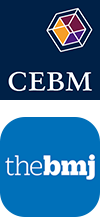



 The Evidence based medicine (EBM) manifesto revolves around the question: why can’t we trust the evidence? (1). A strong question that deserves a follow-up: the evidence of what?
The Evidence based medicine (EBM) manifesto revolves around the question: why can’t we trust the evidence? (1). A strong question that deserves a follow-up: the evidence of what?
Several answers are intuitive but some degree of explicit consideration would be preferable. After all, “evidence-based medicine de-emphasizes intuition” (2) and more importantly, the actual evidence depends on it.
In general, evidence is information, proofs, indications, or traces of something (3). ‘Something’ here can be understood as literally anything, often termed a thing, being, entity, item, existent, or object (4). Evidence depends on the context (3). We constantly act according to this regardless of awareness: what we understand as evidence of a broken leg is different from the evidence of a depression. The assumed or considered properties of the thing that we want evidence about influence the evidence itself.
Same is with science as our overall methodological approach. Very simplified, a change happened in the 19th century of what was considered a disease (3,5). From a holistic view, disease now became distinct, material phenomena, having an archetypical form regardless of the patient. A change in the evidence followed: to be trusted it now had to come from laboratories, based on technology and basic and molecular science(3,5). Later, in the 1960s, Alvan Feinstein acknowledged the evidence from the laboratories. However, as a clinician, he considered diseases as phenomena that evolve with the patients (3). He therefore considered best evidence to be illness observed in clinical settings: clinical epidemiology. In the 70s, Archie Cochrane agreed but pointed out that social surroundings influence as well, making clinical evidence sometimes insufficient to understand diseases and treatment. To bring trusted evidence randomized trials could be needed especially to disclose false beliefs.
Today, how do we consider diseases and how do we develop and interpret evidence on this? How does modern medicine actually consider interrelated medical fundamentals such as disease, diagnosis, risk factor, existential condition, and problem?
The questions may be more relevant than ever: some people now turn into “patients unnecessarily, by identifying problems that were never going to cause harm or by medicalising ordinary life experiences through expanded definitions of diseases” (6). The phenomenon is called overdiagnosis. How is it related to diseases? It depends on how we (unawarely) consider diseases and how we develop and interpret evidence on this.
To reiterate: we need to be explicit in our consideration of both the properties of evidence and disease because they influence each other. Focus only on evidence may create a discrepancy between potentially correct evidence and our fundamental understanding of disease. Overdiagnosis could be a manifestation of such a discrepancy.
The EBM manifesto does not seem to address this, neither do the Guidance for Modifying the Definition of Diseases, the Users’ Guides to the Medical Literature nor GRADE (1,7–9). I, therefore, intend to elaborate on this issue and a potential solution in my presentation at EBMLive this year, and two additional follow-up blogs on this topic will be published after the conference.
References
Christoffer Bjerre Haase is a 2019 Doug Altman Scholar and a researcher and medical doctor from University of Copenhagen. Based on the theory of science, philosophy and evidence-based medicine, Christoffer is primarily interested in the inter-relations between the concepts of overdiagnosis and diagnosis/disease and the ways (medical) science and societal discourses influence those concepts.
Christoffer Bjerre Haase has no conflict of interest.